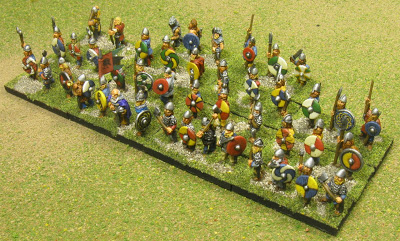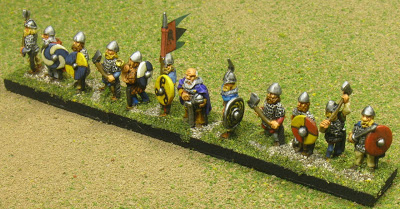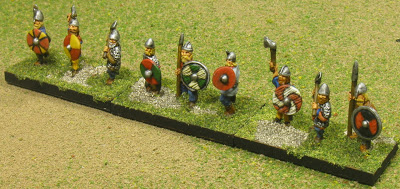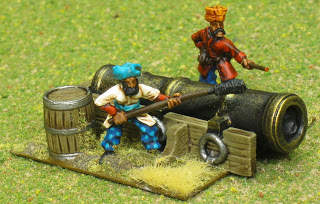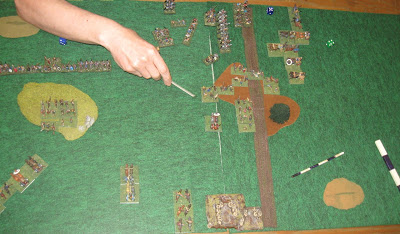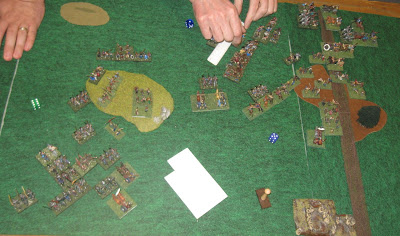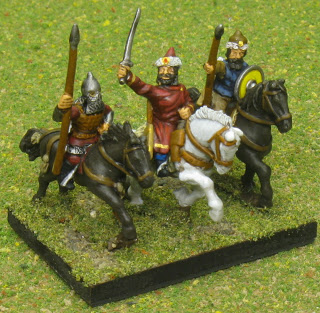Friday: Monsterpocalypse
After BBDBA on Friday night, the only event was the Two Davids giant Hordes of the Things game: Monsterpocalypse Episode 2: Rise of the Terrasaurs – There goes Tokyo!
This was an 8 player HOTT game played on a huge board using rebased Monsterpocalypse figures. Each player had a 24 point army, and sat next to an ally on one side and an enemy on the other. The goal was to capture objectives on the board. Capturing an objective increased your army’s power, and decreased the power of the defensive forces in the city. The first army to capture all 4 of their objectives won.
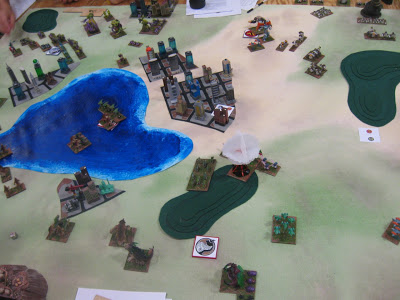 |
| My aerial hero general is nuked |
I was signed up for one of the IOUS slots (Insects of Unusual Size) and Rich Gause took the other. Apparently we left our hive mind at home. I deployed in a completely stupid way and boxed myself in, spending several turns to even get out of my deployment zone. Dave Schlanger decided not to flank my general and kill it in the first 2 turns of the game, but it didn’t extend my lifetime very much. Instead, both of the defense forces to our right beat the crap out of Rich’s bugs.
Soon, Jon Bostwick rolled a 6 and brought out his nuke (a god, in HOTT element terms). This killed off several of Rich’s elements, broke his army, and then started wandering towards the center of the map.
Eventually I unboxed myself, got some PIPs, and flew away. Alex Bostwick, to my left, used a Jedi mind trick to convince me to attack the nuke, and it was a total disaster. We didn’t understand how multiplayer attacks were resolved, and didn’t realize we couldn’t cooperate to flank and destroy it. When it came back to Jon’s turn, he nuked my aerial hero, which broke my army. On my turn, immediately after Jon’s, I rolled a 1 for PIPs, and the rest of my army evaporated instantly (in HOTT, demoralized elements that you can’t hold on the board are removed immediately instead of fleeing).
In The Princess Bride, the ROUSes were killed by fire spouts. I guess when your unusual size is as large as a skyscraper, a tactical nuke is just about the right scale for a fire spout. Even though I was out of the game, I hung around to watch. I left before it finished, but eventually the Terrasaurs captured their fourth objective and won.
Saturday: NICT
The NICT, basically the DBA annual national championship, is open to anyone who has placed first in a NASAMW sanctioned tournament (or second place, for larger tournaments). My win at the Battle at the Crossroads this year qualified me for the NICT, so I got to sit at the big kids’ table this year. The event was played on 24″ boards with dismounting in any bound.
Since the pyramid event I qualified in was so weird, both in terms of tournament scoring rules and special rules in use during play, I decided to use the army I qualified with: Leidang, III/40d. This is not an awesome army within its period: it’s basically bringing blades to a knight fight. I took 1xKn(gen), 5xBd, 3xAx, 1xSp, 1xPs, 1xBw.
In the first round, I faced Greek Alex’s French Ordonnance, on my terrain, and lost 4-1. He really didn’t want to dismount, but he swapped in his blades to dig my auxilia out of the woods. In the second round, Tony Aguilar beat me 4-1, also with French Ordonnance, this time on his choice of terrain, a pool table. I was playing my blades aggressively like knights, and he was playing his knights timidly like blades, but he still ended up beating me. I tried to concentrate my forces on one end of his line, but I didn’t support myself well enough and ended up outflanked and destroyed piecemeal.
In the final round, I had a somewhat better matchup against Ron Giampapa’s Medieval Scandinavians, but I still lost: 5-1 this time. I don’t have any pictures, but this was a straight “line ’em up, knock ’em down” affair with minimal maneuver. The dice didn’t let me exploit any local advantages I managed to create, so my line quickly crumbled.
This wasn’t a frustrating event, but it wasn’t particularly inspiring, either. I prefer themed events over opens, because of the variety of armies present. Even in themes, I’m more likely to choose an army I like instead of choosing my army based on how competitive it will be. Hopefully I’ll eventually get good enough to win despite my army choice.
Saturday: HOTT Open
Tom Thomas ran a Hordes of the Things open tournament with 25mm basing and 4 foot boards. He had plenty of nice loaner armies, so lots of people dropped in who weren’t planning to play. We had 9 players, which let Tom participate to even out the field.
I brought a new version of the Elves of the Offwhite Tower, and got to show off my phallic symbol again… this time complete with a sheath. My army list was: 3xSp (gen), 1xBd, 2xSh, 2xFl, 2xRd, 1xMg. I learned a lot and enjoyed playing the army, but I am likely to change it up before I play it again.
In the first round, I played against Catherine Thomas, who played a Stark army based on R. R. Martin’s A Song of Fire and Ice series of novels. Considering how much mindshare these books are getting among persons whose opinion I respect, I’m going to have to pick up a copy of A Game of Thrones before vacation.
Catherine’s army was very similar to something you’d see in DBA, except with a Hero. I surrounded her with my flyers and started pestering her a lot, but she ended up killing my general and winning 8g-2.
In the next round, I faced Jon Bostwick again, and he had another Boudicca army. This time he had a giant tree for a Behemoth, Boudicca was a hero, and the army was rounded out by a handful of warbands and a couple more chariots (riders). He ended up killing my general, but I was ahead and won 12-8g. For some reason, it seems like the majority of my wins this weekend were against Bostwicks…
I faced Tom Thomas in the final round, also with a Song of Fire and Ice army. This was an interesting battle, but unfortunately we were running out of time and I had to cut it short in order to make it to the Peloponnesian War campaign event.
My magician ensorcelled his magician, and we were at 6-6. He brought his magician back, and I killed his hero: back to 6-6 again. He tried to ensorcell my magician, but he failed and ensorcelled himself, so it was 10-6. He was able to bring his magician back a second time, and then ensorcelled me, bringing it to 10-6 in the other direction. This back-and-forth could’ve gone on for some time, but I was out of time. I hated to concede and leave in the middle of the game, and hated to cheat to lose, so I explained I was short on time and put myself in a vulnerable position for him to take advantage of. It still took a few more turns, but he killed me and won 12-6. Sorry about that!
I learned a lot from this event, and I’m now more inspired to play HOTT more, build at least one more army, and build a few more interesting elements for my Elf army. Larry said it was a bad idea to take both a Magician and Fliers in the same army, and I can see why: they both need 2 PIPs to move, they can’t group move together, and magicians need even more PIPs to use their spells. But they’re both so useful!
In all of my games, I put a second rank of spear behind my general, bringing him up to +6/+6. Eventually I realized this is silly: I should have a Hero general. For the same 4 points, I get a +6/+6 element that moves a lot farther, isn’t quick killed by knights, and maneuvers more easily since it’s only a single element. It’s less flexible, but that only matters if you intend to use the flexibility.
Flyers are very fun. I thought I’d need two of them to make them useful, but I’m not sure this is necessary. One is enough to wreak havoc behind the enemy line, providing flank or rear contacts. I also see much more benefit to taking high PIP elements than before. I thought it would be a handicap to have fewer elements, but you have more PIPs to run the remaining elements, and they’re stronger and more maneuverable.
Saturday: Peloponnesian War Campaign
“It is 431 BC, and things are going to crap.”
 |
| Peloponnesian Campaign Map |
The Two Davids campaigns are the highlight of every convention and a great end to a fun weekend. This year’s event was in ancient Greece, with a bit of Persia thrown in for good measure. I was signed up for one of the Spartan slots, II/5a: 9xSp, 1xCv, 1xAx, 1xPs.
In the first round, I attacked Corinth, played by Alex Bostwick with II/5i. His army was the same as mine, except with one more psiloi and one less spear. This was a fairly straightforward hoplite battle, except for the part where he took my camp with his cavalry. I was eventually in a position to take it back, but by then I had beaten him, 4-c. I controlled Corinth, and had a vassal in the first turn. Yay! This also meant I had a big target on my head.
The Davids, who run the campaign, are becoming famous for getting the lowest numbered tiles in many rounds. After Larry thoroughly searched the campaign tile bag, and demonstrated to everyone’s satisfaction that there was no funny business going on, Dave Schlanger drew the 1 tile in the first round. In the second and third rounds, David Kuijt drew the 1. Shenanigans!
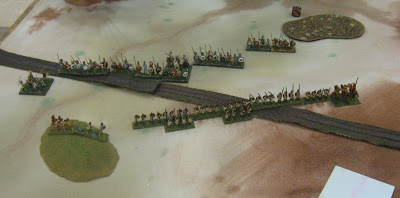 |
| DK’s Hoplite Echelon concentrates force on my left flank |
I was a pretty target, so DK attacked me in round 2. He had an identical army composition to mine. I set up the same terrain as in the first round, approximately. David did something very clever, shown in the accompanying image. I’ve seen and used echelon formations before, but not in this way. He made very good use of the tactic here to deny one of my flanks while concentrating superior force on the other, for a minimum of PIPs, and while mutually supporting his own spears in the process. By the time I saw what he was doing, I had already wheeled into a position that would take many PIPs to send my spears against him… but I was rolling 1’s for PIPs and he was rolling up my line. He beat me 5-0, and I became his vassal.
After I saw what he was doing and commented on it, David again said “It doesn’t always work this well.”
“So,” I responded, “when you say it doesn’t always work this well, that means you can do it but no one else can figure it out, right?”
“Yep, pretty much.”
That “pretty much” guaranteed I had to try this enough times to figure it out. Even if it doesn’t always work, it’s important to learn more tactics so you can not only use them, but protect yourself from them and find ways to beat them.
In the third round, Mark Pozniak attacked me with his Athenians. I tried the echelon tactic, but it didn’t work correctly. I ended up leaving my general’s flank open, and after several turns of back-and-forth combats, he eventually beat my general and won 3g-0. I made some mistakes I should’ve avoided, but I was more interested in learning this new way than practicing what I already knew.
In the last round, Jon Bostwick attacked me, again with the same army composition I was using… and again, I attempted the echelon tactic. Again, I left my general’s flank open, but I realized it a bit earlier and was able to protect it somewhat. However, it didn’t help me win, and he beat me 4-0.
When I think about hoplite battles, they always seem boring and uninteresting to me. This is probably because it’s a typical army choice for demonstrating DBA to new players, where hoplite battles are typically played out in a very straightforward fashion for the benefit of the new player. When I actually play with hoplites against an experienced opponent, it’s a lot more fun.
I finished this year’s campaign in the middle of the pack, which was satisfying, but more importantly I learned new ways to play this army, gained a greater appreciation for it, and best of all I had fun.
Another year of Historicon is over, and no one knows where next year’s show will be. I guess we’ll find out eventually, if the convention actually happens in 2012, but depending on where it’s held I might not end up attending.
